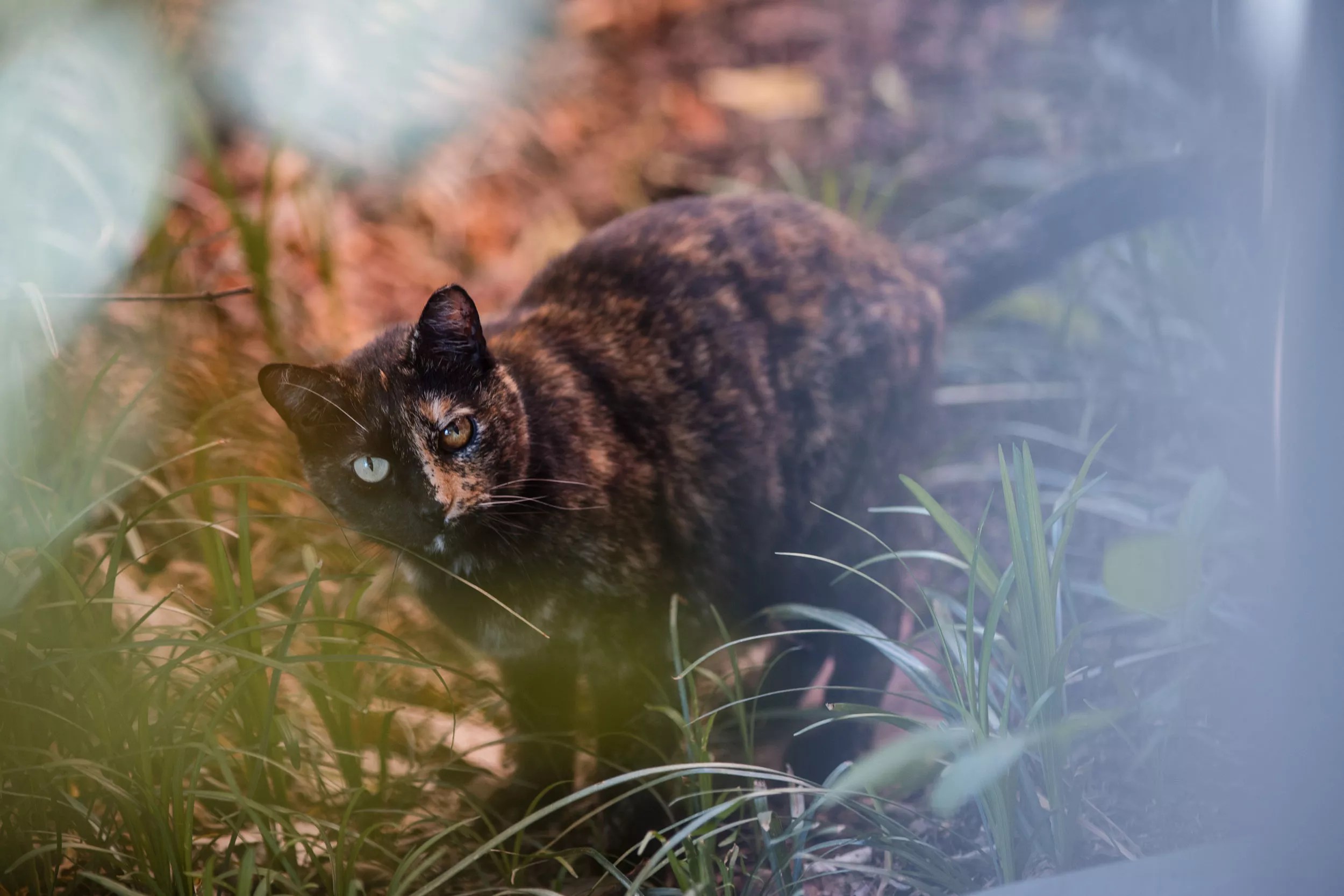
Nathan Hunsinger

Audio By Carbonatix
UPDATE, 10/14/2025: On Oct. 5, Bishop Arts property manager David Spence and Lisa Dennis of animal advocacy group Cats in the Cliff issued a statement announcing an agreement “to end their dispute over Mr. Spence’s trapping and relocation of cats that are part of colonies managed by Ms. Dennis and other cat advocates in the Oak Cliff neighborhood of Dallas.”
The statement goes on to note that Spence agrees to stop capturing the feral cats, apologizes for the suffering he may have caused and will make donations to animal charities endorsed by Dennis. For part, according to the statement, Dennis has agreed to end the regular protests that have taken place outside of Spence’s properties while also expressing regret for any “strain or concern” the protests may have caused.
“We realize that we both love the Oak Cliff community and want the best outcomes for the people and the animals who live there, which includes the unowned, outdoor community cats and wildlife,” the statement reads. “We have both learned from this experience and reached agreement on how we can work together going forward by maintaining an open, respectful and constructive dialogue.”
Original article from April 14, 2025, below:
In Bishop Arts, a war is brewing between a developer and embittered animal rescuers. Several dozen stray cats are caught in the middle.
The feral cats of the Bishop Arts District in North Oak Cliff are fat, happy and everywhere.
There are fluffy black ones and short-haired spotted ones; ones with swishing tails and ones with white feet that look like socks; cats that dart at the sight of a person and cats that sunbathe outside Dallas’ best restaurants while waiting for scraps to fall from a table. The arms of dog walkers are forever at risk of being yanked out of socket by a canine lunging after a particularly unbothered cat, or one of the piles of kitty kibble left by well-meaning animal advocates throughout the neighborhood’s alleys.
The free-roaming felines aren’t pets, several women who take care of Bishop Arts’ cat colonies told the Observer, but they aren’t unloved, either. The women utilize Dallas’ trap-neuter-release (TNR) program – where feral cats are trapped and taken to a Dallas Animal Services partner clinic for vaccinations and neutering before being rereleased into their home neighborhood – to keep the populations of their respective colonies stable.
Caring for a cat colony can be a decade-long commitment, said Lisa Dennis, the founder of the Oak Cliff-based rescue group Cats in the Cliff. When you’ve cared for a group of cats for years on end, it doesn’t take long to notice when cats have gone missing. And when a cat goes missing in Bishop Arts, Dennis is sure she knows who to blame.
By her count, at least six neighborhood cats have gone missing so far this year. It has reignited a feud between Oak Cliff’s most dedicated cat activists and David Spence, the founder of the Bishop Arts-based development group Good Space.
According to Dennis, Spence has repeatedly trapped Bishop Arts’ kitties and dumped them off on Interstate 30 in Grand Prairie, where they have no access to food or water and could become prey to larger wild animals. She first encountered this problem in 2021, and the clash with Spence has reignited in recent months despite the pleading of community members who care for the neighborhood’s cat colonies, she said.
According to Spence, setting out a non-harmful trap to capture any critter causing a nuisance is his right as a property owner. Bishop Arts’ community cat problem exemplifies the gap that exists between Dallas’ city code and a 21st century cultural obsession with pets. He also points out that organizations like the Texas Parks and Wildlife Department warn that TNR programs could pose public health risks, a concern for a property manager in a restaurant-heavy area.
“He hates cats,” Dennis said of Spence in a recent conversation. “He is a total jerk and an animal hater. … I’m tired of people like him getting away with this kind of thing.”
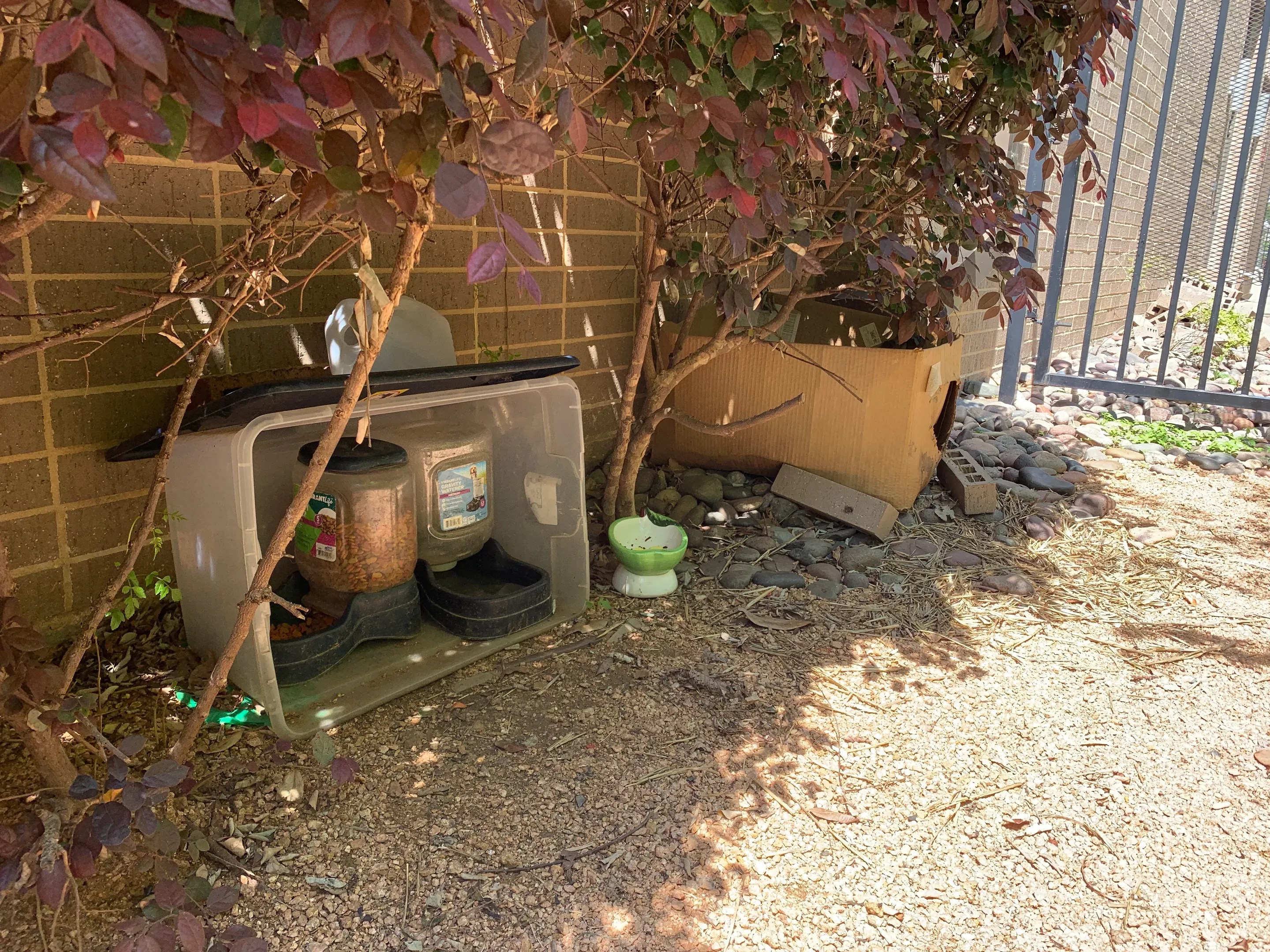
Food and shelter for feral cats can be found next to an apartment complex on Melba Street.
Emma Ruby
The First Case of the Missing Cats
The tension between Dennis and Spence dates back to 2021 when Dennis noticed the colony of 20 cats she’d been feeding for a decade had disappeared. Months earlier, Dennis had been out in the neighborhood feeding her felines when she says Spence approached her and began discussing his intention to trap the cats.
“Basically, I told him they’re fixed, they’re cared for, and I left that conversation that day thinking that he wasn’t going to mess with them, he wasn’t going to bother them,” Dennis said. “It was so settled that I didn’t realize what was going on, but [a few months later] my colony started dwindling. And then, one day, I went there, and all the food I had left from the day before was still there. And I was like, ‘My God, what has happened?'”
Dennis confronted Spence about the missing cats after finding traps in the neighborhood’s vicinity, and “begged” him to tell her where the animals had gone. In a recording of a phone call between the two that was shared with the Observer, Dennis asks, “Did you really dump the 14 [cats] in Grand Prairie?” Spence told the Observer he does not recall having the conversation with Dennis, but acknowledges that the male voice in the recording sounds similar to himself.
“Yes,” Spence responds. “They all went to Grand Prairie except for one who was in my car when I went up north, so he went to that park in North Dallas.”
Spence directs Dennis to an “undeveloped parcel” of land near I-30 and MacArthur Boulevard, where he’d left the cats captured in Bishop Arts. Dennis said she spent “months” leaving food in the area in hopes of reuniting with her colony, but only one cat was ever found alive. One cat was found dead, and the remaining dozen were never seen again.
“I just remember being so devastated,” Dennis said.
In the phone call recording, Spence tells Dennis he’d like to “work out a system” to tackle the neighborhood’s cat problem together, but Dennis rebuffs the suggestion as futile, stating that removing cats from Bishop Arts will only make space for other mammals to move in. She said she went to authorities in Dallas and Grand Prairie, where she begged for accountability for her missing cats, but nothing ever happened. She said she posted to the NextDoor app about the situation and was reprimanded for disparaging a man known around the neighborhood for being “a philanthropist and such a great guy.”
Her frustration had reached a fever pitch when, a few months later, Dennis drove past Spence in Bishop Arts on her way to visit her cat colony.
“I just screamed out [my window], ‘Don’t F with cats!’ And I’m not one given to profanity, but I did say that,” Dennis said. “I was just so scared he was going to do something that night. So I came back the next day to feed my colony and some man or woman – I don’t know, but it was a human – there was a pile of human excrement by my feeding bowls.”
Dennis clarified that she isn’t accusing Spence of the defecation but merely speculating about the incident’s suspicious timing. (We asked Spence about this theory, and he started laughing before clarifying he did not, and has not ever, relieved himself in the streets of Bishop Arts.)
After that encounter, though, the hostility between Dennis and Spence seemed to cool. As far as she could tell, Bishop Arts’ cat colonies had returned to normal, and she didn’t see any traps around for the next few years. Then, last December, rumors began to swirl among the Oak Cliff cat-rescuing community about missing food dishes in Bishop Arts.
Dennis immediately knew who to blame. She said it had been nearly three years since she’d last spoken to Spence when, on Dec. 20, 2024, she texted him a warning.
“I understand that you are at it again with the cats. I’m sure you never stopped,” she wrote. “FYI, we are aware.”
Since that December text message, Dennis believes around six more Bishop Arts cats have gone missing. Cat advocates have photographed traps left around the neighborhood as recently as late March. Meri Dahlke, the owner of Ten Bells Tavern in Bishop Arts and a self-proclaimed “cat influencer,” started a petition calling for the end of Spence’s “cruel and harmful behavior” that had garnered over 1,500 signatures at the time of publishing.
A dozen reviews accusing Spence of being a cat killer have been left on his business’s Google page, and an especially embittered coalition of cat ladies have discussed covering his front lawn in used kitty litter – something Dennis says she does not support. One woman who lives in the Bishop Arts neighborhood has taken to jumping the fences of Spence’s properties to steal his traps or free any cat that has been captured – that, Dennis understands.
“When it comes to animal rescue, that kind of stuff can’t stop you,” Dennis said. “When it comes to saving an animal’s life there’s not much you won’t do.”
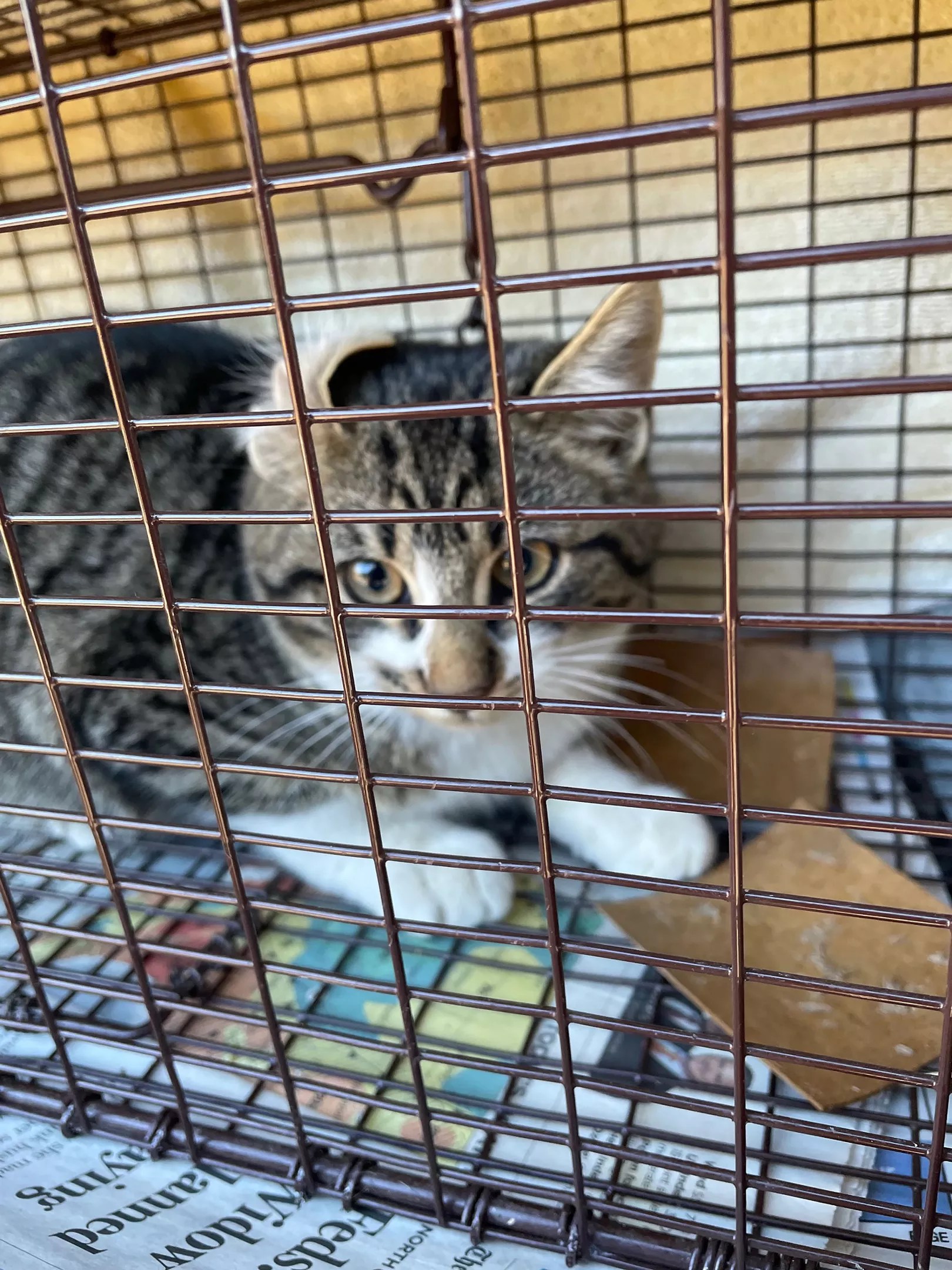
A cat that Lisa Dennis, founder of Cats in the Cliff group, was able to trap in Grand Prairie to return to Oak Cliff.
Courtesy Lisa Dennis
Critter Control
When David Spence called the Observer to talk, it was Chapter 7 of Dallas’ City Code that he wanted to discuss – after, that is, he emphatically emphasized that he is not a cat killer.
He was fresh off a trip to a remote part of Honduras, and the first thing he did when arriving back stateside was walk through Bishop Arts with the director of Dallas Animal Services. There, he discussed how Chapter 7 fails to consider “modern sentiment towards cats.”
“The code back in the day was designed for mean old people who lived in a trailer and kept their dogs on a short leash or staged dog fights and things like that. The kind of animal cruelty that anyone would understand,” Spence said. “There are a couple of fleeting references in the code to trap-neuter-release programs. But the code does not at all [acknowledge] that TNR cats are not old-school-style feral cats, but they’re also not pets. They’re not owned cats. And so there is this gap in the code with, well, how do you manage that? What are the obligations?”
In Bishop Arts, where an abundance of apartment complexes make for a transient community, Spence worries that a colony could be registered with the city by a well-intentioned cat lover, only to be abandoned when that person’s lease expires and they decide to move. Or, to consider more morbid implications, what happens to a colony when a caretaker dies?
While Dallas’ city code considers how to handle instances of dogs being kept outside in harsh weather, the transport of animals in truck beds and how many animals are allowed to reside in a single dwelling unit, stray cats are a gray area. In fact, a city ordinance actually states that cats within the TNR program should be excluded from a dwelling unit’s animal headcount, leaving the vagrant kitties largely unregulated. That has opened the door for rescuers like Dennis, whose cat care is as dedicated as it is volunteer-based, to step forward as sponsors for colonies.
Dallas Animal Services does have a community cat application online that asks for the contact information of a “colony manager,” as well as details about the colony’s location and size. Dennis said this is the application she filled out, formalizing her Bishop Arts colony. But a spokesperson for Dallas Animal Services told the Observer that the department does not actually have a database keeping track of how many cat colonies are sprinkled across Dallas, or where they are located. DAS is “currently working on” identifying the needs of the community to strengthen the TNR program moving forward.
By Spence’s estimation, there are three cat colonies that call Bishop Arts home, each consisting of around 20 cats. When stray cats are taken into DAS for neutering, their right ear is notched to mark them as part of the TNR population.
“My guess is that when someone says, ‘I think I want to start a cat colony,’ Bishop Arts is fashionable because you can come feed your cats and then you can get a latte and then you can go to yoga,” Spence said. “And so ironically, under the TNR regime, Bishop Arts has more cats now than it had back in the good old days of just mean, stray, fertile cats.”
TNR programs are a relatively modern solution to a timeless stray cat problem. In 2023, Texas Gov. Greg Abbott signed TNR into law after the programs had spent years operating in a legal gray area. In Texas, animal abandonment is a misdemeanor crime, so House Bill 3660 was passed without opposition to allow animal rescuers like Dennis to return neutered cats to their home territories without risking prosecution for abandonment.
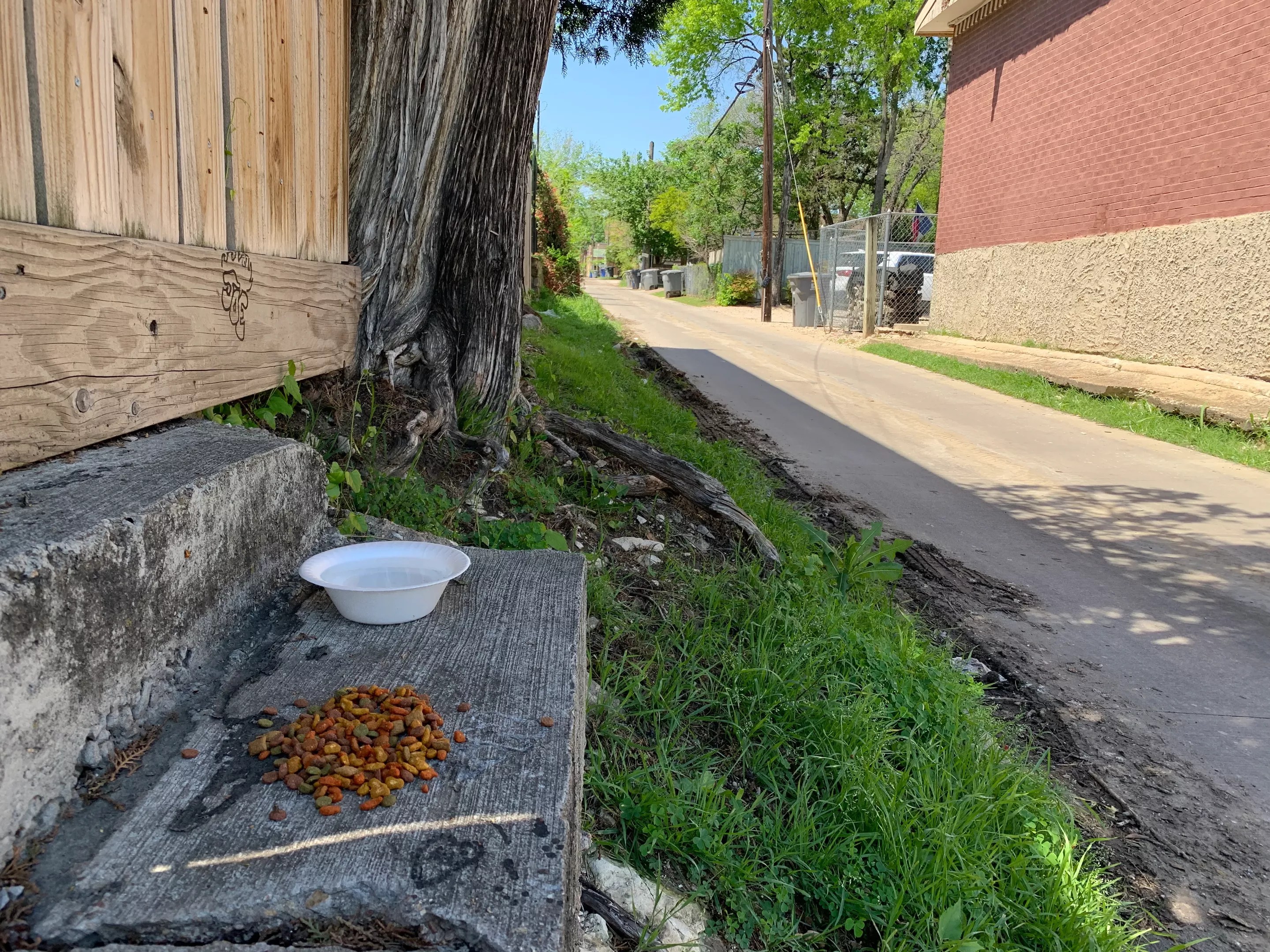
Piles of cat food litter the alleys of Oak Cliff.
Emma Ruby
According to Dallas Animal Services, the TNR program is the most effective way to manage stray cat populations because it prevents population growth via sterilization and offers an opportunity for feral cats to be vaccinated, tempering the risk of disease. Advocates say that when community cats are removed from a territory, it creates a vacuum effect, leaving the area unguarded and allowing outside cats that may be pregnant or ill to fill the vacancy.
But People for the Ethical Treatment of Animals and the Texas Parks and Wildlife Department oppose TNR, saying the program is ineffective in preventing humans from being exposed to diseases and can result in cats being left in harmful or stressful environments.
“Neither intentional feeding of free-roaming cats or the sanctioning of managed cat colonies addresses ecological, animal health, or public health concerns,” the Texas Parks and Wildlife Department says in a document explaining the organization’s position on TNR programs. “Additionally, TNR programs are not effective at alleviating the threats of feral and free-roaming cat colonies on feline health, human health or native wildlife populations.”
For a property owner who manages properties used for residential, retail and restaurant purposes, the potential threat to human health that stray cats could pose is especially worrisome to Spence. The Bishop Arts cat colonies tend to congregate in alleys behind the neighborhood’s restaurants, and Spence said he’s concerned about the risk animal excrement, especially in a concentrated area, could pose to the nearby human traffic.
Moreover, many of the buildings in Bishop Arts are old, historic homes that are hard to make critter-proof. Crawl spaces underneath the properties are inviting homes for any number of mammals, and Spence said he has had to combat two flea infestations in residential properties where he maintained a no-pet policy because of stray cats living under the homes.
“I have a certain obligation to my tenants. I have a contractual obligation, particularly in buildings that have food service operations or that have residential functions, to control the pests in that area, whether they’re a mosquito or a badger,” Spence said. “I can’t just shrug my shoulders and say, ‘Well, sorry about the flea infestation.'”
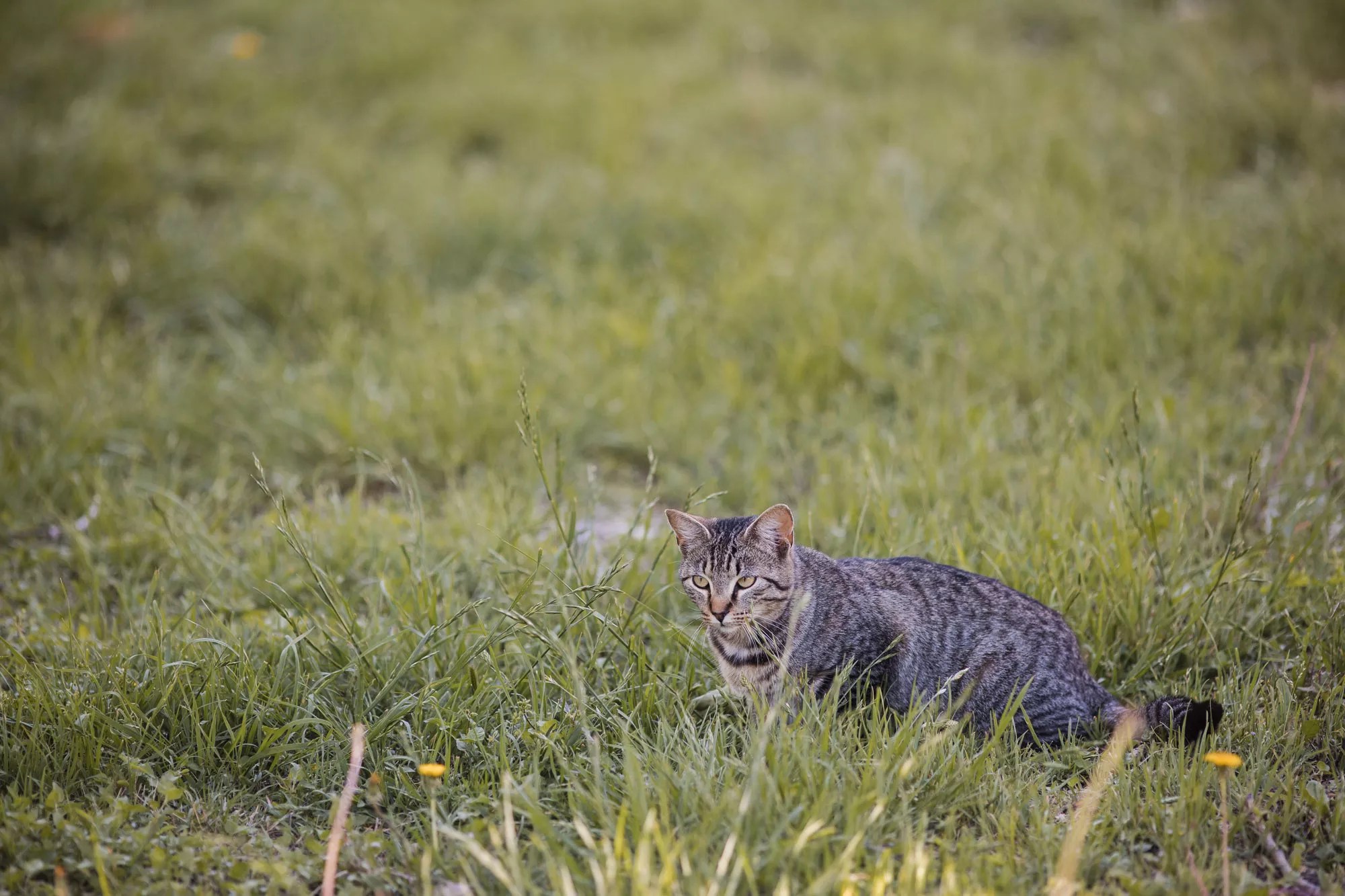
A cat enjoys freedom (for now) in the Bishop Arts District of Oak Cliff.
Nathan Hunsinger
A Sentimental Divide
Dallas Animal Services data shows that in the 2024-2025 fiscal year so far, 173 cats have been treated as part of the TNR program. At the end of the last fiscal year, nearly 350 cats had been neutered, vaccinated and re-released onto Dallas’ streets.
That is hundreds of cats on Dallas’ streets that, just two decades ago, would have faced euthanasia at the animal shelter, rather than medical care. An Observer article from 2011 describes our city’s shift in thinking on this topic when Dallas police chief-turned-mayoral candidate David Kunkle declared his intention to make Dallas a “no-kill city.”
While Kunkle didn’t win his election, the city agreed with his position as, at that point, close to 75% of all animals taken into the shelter were being put down.
This is the part where, if Spence and Dennis weren’t seeing eye to eye before, their backs fully turn on each other. Spence believes that the city’s decision to get out of the business of stray euthanasia has left property owners burdened with an “impossible situation.” When he bought his first property in Oak Cliff, he was taught by a neighboring businessman that pest control didn’t need to be any more complicated than buying a trap from Elliot’s Hardware and taking care of business.
Twenty-nine years later, his feelings on the matter haven’t changed, even as the culture surrounding animal welfare has.
“You’d get a cat trap, you’d put some cat food in it, you’d catch the cat and then you’d take it to Animal Services, which at that point was a humble little building. It was called Animal Control, and it was next to the zoo,” Spence said. “And I said, ‘So just out of curiosity, how did you get the cat out of that trap?’ They said, ‘Oh, we have a very long needle.’ So back in those days, that was how animal control was done. Stray animals were unsentimentally put down. Humanely, but unsentimentally.”
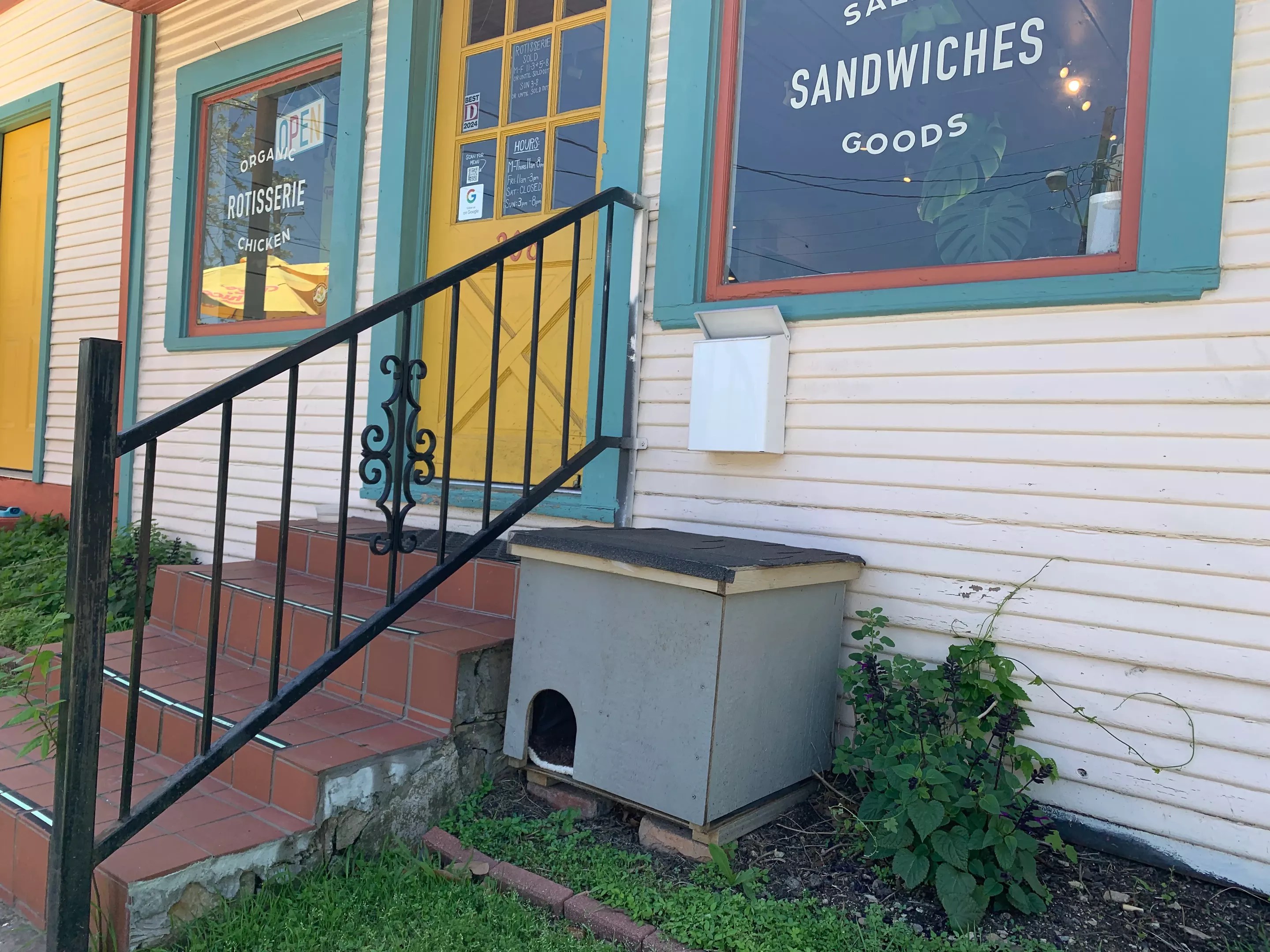
A cat house sits outside La Bodega in Oak Cliff. The house was made for a specific outdoor cat named Leftovers who is the mascot of Bodega and Taco Y Vino.
Emma Ruby
To Dennis, this is an admission of evil.
Outside of Dallas, some cities are beginning to consider the legal gray area that feral cat colonies operate in. In New York City, animal advocacy groups are rallying around a call to decriminalize the cats living in the city’s bodegas and corner stores. It is currently illegal in New York state to allow an animal to live in a food-selling shop, and owners can face fines if caught by inspectors. Fans of the cats argue they’re useful for chasing off rodents or cockroaches. And, they just make people happy.
Dahlke, the Bishop Arts bar owner, told the Observer as much.
“In Bishop Arts, our cats are part of the fabric of the community,” she said.
On the other hand, small-town Strasburg, Ohio, located South of Cleveland, approved an ordinance last year that bans anyone other than caretakers registered with the city from feeding or sheltering stray cats. The ordinance came after residents complained that a burgeoning feral cat population was turning the village into “one big litter box.”
Dennis has been made chief watchdog of the ongoing Bishop Arts cat debacle; she has been sent photos of cats captured in traps left outside businesses as recently as March 26. Her voice sounds defeated as she looks at an image of a black-and-white feline bracing itself against the bars of a cage left outside Emporium Pies, a Good Space property. (She confirmed that the cat in question was soon after released by a friend of Dennis’.)
She believes humans need to be better about embracing a harmonious existence with animals; after all, she said, we encroached on their homes in the first place.
“It’s a work in futility trying to rid any area of any animal. It’s not going to happen because people are always going to dump and allow animals to roam,” she said. “It’s just the way it is, the nature of our world.”
At this point, Spence says he does not have any traps out in Bishop Arts. He wants this whole drama to blow over, and in the meantime, he has issued a statement on the Good Space Facebook page clarifying that he isn’t a cat killer, he’s merely relocating the pesky felines.
For the TNR true believers, though, there is little distinction between killing and relocating, and the drama doesn’t seem to be calming down. On a recent walk through Bishop Arts, we asked a business owner if they’d heard about the neighborhood cat controversy.
“Oh yes,” the business owner said, eyes widening. “I heard he takes the cats and kills them. That he has a fetish for killing cats.”
An attorney by training, Spence is putting together a legal analysis of Chapter 7 of the Dallas city code to point out all the loopholes and gray areas that have allowed cat colonies to thrive in his neighborhood. Fixing the code could take several years, though, a frustratingly long amount of time, he said.
“I didn’t set out to catch cats. I need to thwart whatever critter it is who wants to make the crawlspace of a building a home,” Spence said. “I don’t have any [traps] set out now, but if tomorrow I decided as a property owner that on my property I’ve got a critter problem, then yes. I would lawfully set out a trap.”